1972 Austrian Grand Prix race report
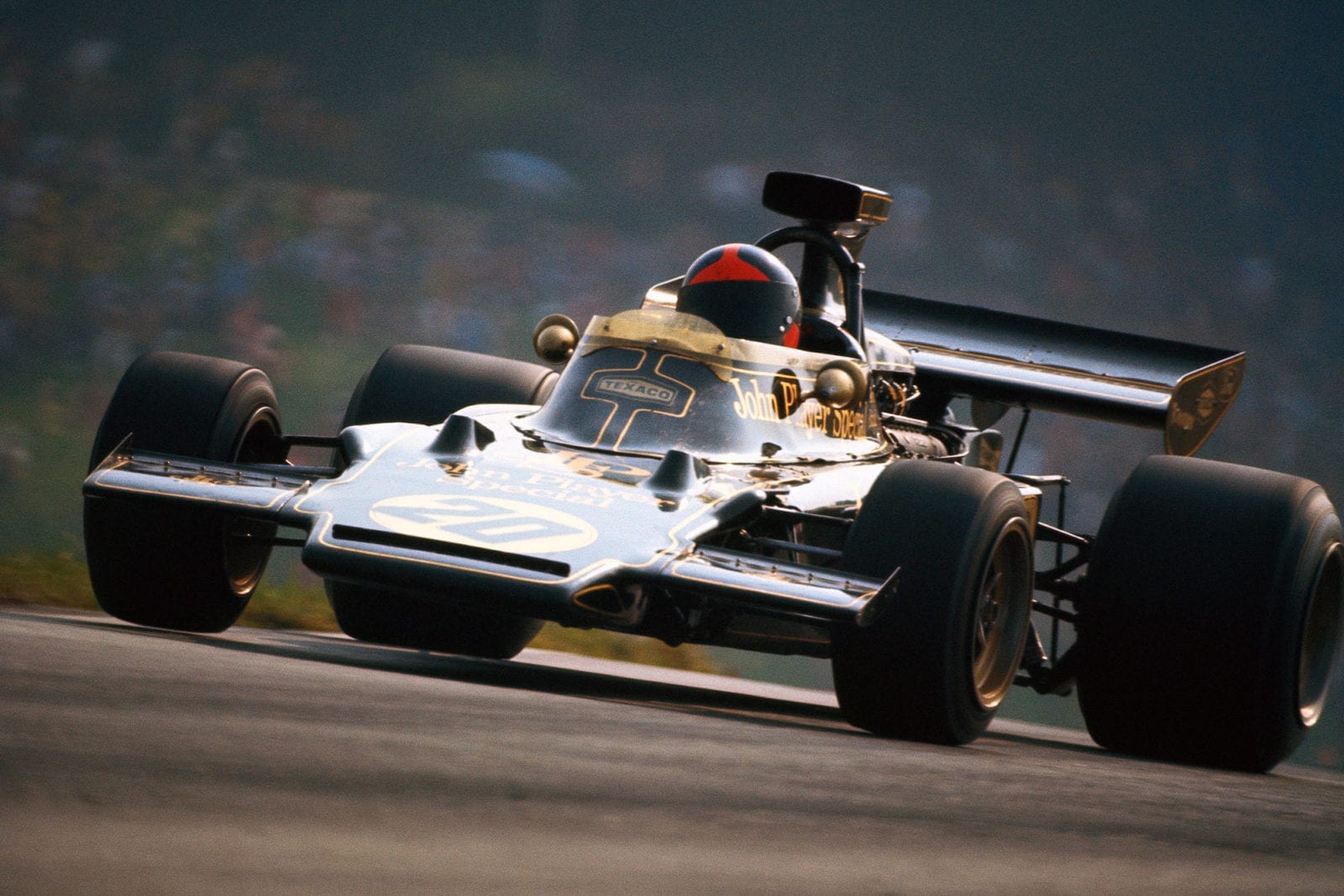
Emerson Fittipaldi won a third race of the 1972 race for Lotus
Motorsport Images
—A fast race
Osterreichring, Zeltweg, August 13th.
It is easy to forget that the permanent race-track, built on virgin soil in the hills overlooking the village of ZeItweg, was opened only three years ago, in the middle of 1969 to be exact, and that the first International race was the 1000 kilometre Sports Car event held in the Autumn of that year. Even before the third Austrian Grand Prix took place on August 13th, with practice on the preceding Friday and Saturday, there was a feeling of attending an established “classic” Grand Prix. Everyone had entered, everyone turned up, and the overall feeling was one of satisfaction all round, a feeling added to by the Austrian weather, which was superb. Some new events on the International calendar seem to take many years before they are accepted or before they form any character of their own, but the Austrian Grand Prix has achieved all this in its third year of existence on the Osterreichring. There was a Formula One race on the old airfield circuit in 1963, and a World Championship event in 1964, when the Austrians were told by the FIA that they were well capable of putting on a Grande Epreuve, but the Zeltweg airfield was not the place to do it. “Leave it to us”, said the KnitteIfeld section of the Austrian Motor Sport Club. Three years later the land had been purchased, a year later the bulldozers were at work and in 1969 the first race was held. As far as the Grand Prix is concerned it has but two years of history and already they have become classics, prompting people to say, “Do you remember when . . . “. Will we ever forget 1970 when Ferraris were first and second and the enormous crowd of visiting Italians besieged the paddock; wave after wave of Ferrari enthusiasts descending from the hills, each with its Ferrari flag ? No sooner had the cheering died down than a new wave would arrive and the siege of Ickx and Regazzoni started up again. One seasoned Grand Prix follower likened it to a mediaeval war! “Banners held high, the victorious cheering mob marched on.” Up to midnight after the race Italian registered cars could be seen heading home, the occupants cheering and waving as they carried the news of the great victory back to Italy. And 1971? Good old Siffert (God rest his soul) led from start to finish in a BRM, and his enormous following of central European enthusiasts kept the beer tents ringing with Swiss songs until well after dark. And his dear old mother was there to see it all, weeping tears of joy at Joseph’s great victory. Such is the bitter irony of life, and especially our sport, that weeks later we were all weeping tears of sadness at Joseph’s death at Brands Hatch. He may not grow old, but we shall remember him, and the Osterreichring will remember him.
Already, in only its third year, the Austrian Grand Prix is accepted by everyone. Already it is a classic event that no-one wants to miss. Probably it is due to there being nothing before, unlike the new Paul Ricard circuit, which has to justify being the replacement for Reims, Rouen or Clermont-Ferrand, or the Belgian Nivelles circuit, which has to justify being the replacement for Spa-Francorchamps. Even the Jarama circuit has to justify its alternate replacement for Barcelona, and the rebuilt Hockenheimring tries to justify being the replacement or Nurburgring and the Solitude circuit. The Osterreichring does not have to justify itself, its whole conception was right from the start, and the more people who visit it the more people realize that true Grand Prix racing does not have to follow the clinical and dull dictates that originate from America and produce such “marvels” as the Paul Ricard circuit in France, and the Nivelles circuit in Belgium. Maybe I do “bang on” a bit on this subject, but I believe in European Grand Prix racing that was born on the road, and I will fight to the last foot of Armco barrier to defend what I feel is right, and for me the Ostereichring is right, in a truly modern context.
Not only did everyone enter for the Austrian Grand Prix, but nearly everyone turned up, except Reine Wisell, who was entered by one hand of the Marlboro-BRM complex, and dropped by the other hand. The only other non-starter was the new Surtees car, for reasons explained elsewhere. On the Thursday afternoon before the race there was free practice for anyone who wanted it and it was a rather pleasant and mutely affair, with no time-keeping, nothing to win or lose, the sponsors admen had not arrived and everyone was refreshing and relaxed and almost human. Team Lotus had sent a small group with 72D/R5 as an advance guard and Fittipaldi was carrying out experiments with a very neat cover over the engine which deflected air down to the rear oil cooler, and Walker was waiting in vain for a drive in the car. Ferrari had their full team of cars and drivers out practising, and March were experimenting with a new nose cowling. The new Tyrrell 005 was having its front brakes assembled on the hubs, instead of inboard, and meanwhile Stewart was getting in a lot of laps with 003, repaired after its mild accident at the Nurburgring.
Qualifying
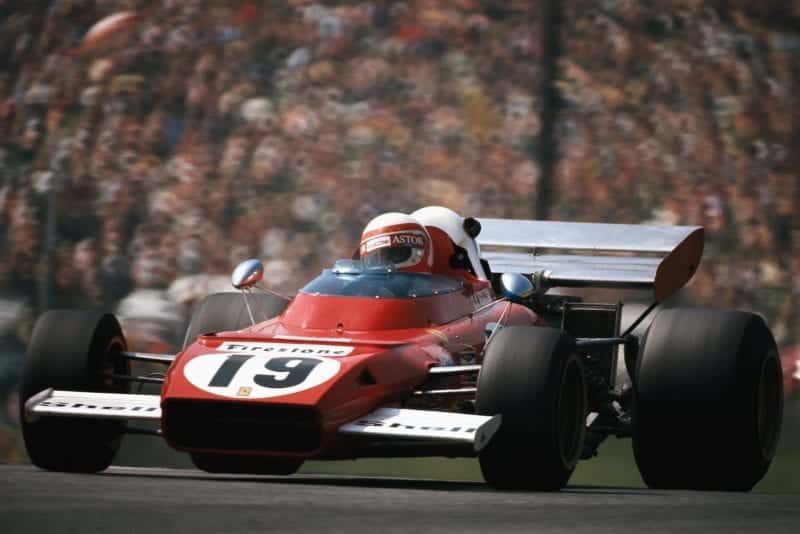
Clay Regazzoni qualified his Ferrari 2nd
Motorsport Images
The serious business of practice began at 2.30 p.m. on Friday afternoon, going on until 6 p.m. with a 30 minute break “to remove any wreckage and sweep up the mess”, as it said in the regulations. Last year Siffert held the lap record at 1 min. 38.47 see,, a speed or 216.280 k.p.h.. and with twelve months of engine development, chassis development and tyre development, at least one whole second was expected to be chopped off this time. During the first part of the afternoon it was incredibly hot, and engines were having difficulty in breathing, but as the sun began to go down conditions were more favourable and some very fast times began to appear. As one would expect Stewart was pace setting with the new Tyrrell, but quietly and almost unnoticed Peter Revson was also going incredibly quickly in the brand new McLaren, indicating that the workers at Colnbrook know how to build a racing car. After a lot of hit-and-miss adjustments between rear aerofoil angle and rear wheel camber angle, the Lotus team arrived at a compromise on their spare car, 72D/R5, that suited Emerson Fittipaldi and he recorded 1 min. 35.97 sec. just before practice finished, which put into the shade the 1 min. 36.35 sec. of Stewart with Tyrrell 005, and the 1 min. 36.98 sec. of Revson. As can be seen from the accompanying table of practice times, Peterson, Ganley, Amon, Hulme, Hill, Ickx and Regazzoni all improved on the old lap record, but the pace-makers had already established times of under 1 min. 37.0 sec. as being in the “A” category, so beating the old record was child’s play, or should have been. Ganley’s time of 1 min. 37.55 sec. put things into perspective in the BRM team, and Hill was very happy with the new gearbox in his Brabham, as his time of 1 min. 38.14 sec. suggested. Hailwood did not keep going until the cool of the evening as his clutch gave out, and Schenken was abandoned out on the circuit when an electrical fault burnt out the ignition unit.
Before the afternoon cooled everyone’s progress was slowed up by the Connew splitting its oil tank and lubricating the circuit, and Gethin’s BRM was spilling liquid on left handers. The new Tyrrell had the air scoops to the side oil radiators extended with sheets of aluminium, and the Ferrari engineers were very distraught as vapour-locking occurred in the most unlikely places in the fuel system, and air bubbles in the Lucas fuel injection unit do not make for a clean pick-up. Henri Pescarolo crashing Frank Williams’ March 721 is no longer news, whatever the cause, and it went almost unnoticed, while Ickx abandoned his Ferrari with a dead fuel system and continued with the spare car. Fittipaldi was fast all the time, but fastest of all with the spare-car, and Revson was either exceptionally good, or the others were all exceptionally bad; it was difficult to decide.
On Saturday the heat was greater than ever, and practice was brought forward from 2.30 p.m. to 1 p.m., ending at 4.30 p.m., instead of 6 p.m. Consequently there was no hope of anyone doing any super-fast laps, due to the high temperature. Hulme and Revson both used the spare McLaren, and Beltoise used the spare BRM, but March did not use their experimental car anymore. Everyone was struggling to get below 1 min. 38 sec. and as the afternoon heat continued it was clear that most of the starting grid position been decided. Once again Revson was smoothly fast, confirming the previous day’s impressions, and Fittipaldi was fast in both his cars. Right at the end of practice Regazzoni was running on some well established Firestone tyres, and the fuel system stopped playing-up for a short time, which allowed him to get a lap in 1 min. 36.04 sec., fastest of the afternoon. By the time he saw the pit signals requesting him to stop so that the well-worn tyres could be put on lckx’s car, practice finished, which did not make him too popular in some circles. With the Tyrrell pit being at the beginning of the row of pits, Stewart was able to do some fantastic practice starts as he set off out of the pit lane, but the tyre marks from the spinning back wheels would have depressed a drag-racing enthusiast, and should have caused the designer of the rear suspension some worrying thoughts on geometry, for the rear wheels appeared to ride up onto the outside edges of the tyres. Beltoise had his BRM engine break on him and Beuttler spun off and damaged the rear end of his March, necessitating robbing the spare works car of bits to make the “Stock-broker Special” race-worthy.
Race
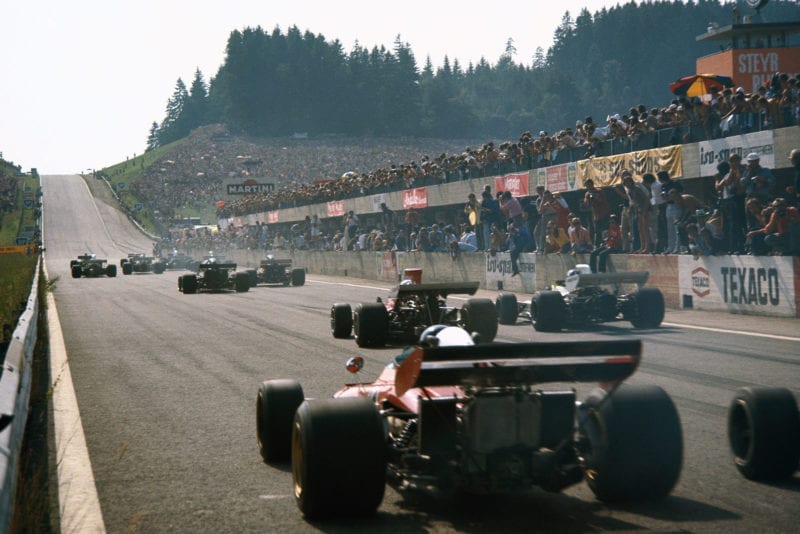
The race starts
Motorsport Images
Apart from Pescarolo, whose March could not be repaired, everyone was in the race, and on Sunday morning there was a free-for-all practice session for those who wanted it. The engine in the new Matra blew up, necessitating some frantic work in the paddock to install another one, while the injection system on Beuttler’s Cosworth engine went wrong when the car started up, preventing him trying the-car after its rebuild. Stewart was out in Tyrrell 005 wearing the vast air intake over the engine with which he intended to race, and the funny handling on Pace’s March was traced to the wrong tyres being used. The start was due at 3 p.m. so the morning was taken up with a Formula Super Vee race won by the Lichtenstein driver Manfred Schurti in a Royale, some publicity parades by the Austrian motor trade and aerobatics by the RAF Red Arrows and their Folland Gnats.
For three days people had been pouring into the Zeltweg plain many of them camping in the fields around the circuit, the beer tents, the hot-dog stalls and the fair-ground doing enormous trade from them, and by the time the Grand Prix cars came out into the pit road the crowd estimates varied from 100,000 to 150,000, and whichever limit you accept there were a lot of people about the place. The grid was due to line up in offset pairs and whatever choice he made Fittipaldi was on the front row for he was fastest on Friday in R5 and second fastest on Saturday in R7, Regazzoni being between the two Lotus times. The Brazilian decided to use his spare car R5, as he felt happier with it, and he took pole position without any Fleet Street writers weeping tears into their Telex machines because he had to use his “older car and suffer a handicap”! After a warm-up lap the cars assembled on the “dummy grid” with mechanics and team-managers protecting their cars and drivers from the heat of the sun with umbrellas and sheet, and at the signal from the time-keepers the 25 cars moved forward to the starting line, ready for 54 laps of the undulating and extremely hot 5.911 kilometres of the Osterreichring.
From the outside of the second row Stewart made the sort of start of which Regazzoni would have been proud. The blue Tyrrell left the Line like a rocket, dived across to the right behind Regazzoni’s Ferrari, in front of Revson’s McLaren and joined the front row on the inside almost before some of the slower backmarkers had got their clutches home. Three abreast, Fittipaldi, Regazzoni and Stewart accelerated up the steep hill from the starting area, and it was the blue Tyrrell that took the lead over the brow. The racing driver in J. Y. Stewart had complete hold, and it was a superb display of what we all enjoy seeing, and his lead at the end of the opening lap brought forth gasps of admiration from everyone. Regazzoni was in second place with a howling mob behind him, many of them undecided about their immediate future! The red Ferrari was in trouble with its injection system and was hesitating out of the corners, giving those behind some anxious moments, and the order of the queue was Fittipaldi, Hulme (after a super start almost matching Stewart’s), Reutemann, Revson, Amon, Schenken, Hailwood, Peterson and Hill. For four laps Fittipaldi sat a discreet distance behind Regazzoni and then on lap five he saw his chance and dived past, into second place, but already the fleeing Stewart was nearly out of sight. Slowly but surely the black and gold Lotus began to close the gap on the blue Tyrrell, and the rest were left behind still trying to find a way round Regazzoni’s Ferrari that was far from being on top form. The other Ferrari was, running equally badly and poor lckx was down in fourteenth place, only just ahead of the Tecno. Hulme got by Regazzoni on lap 9 and then everyone went by and at the end of eleven laps the Ferrari was in the pits having water poured over the petrol cooler and the petrol pumps, to try and cure the vapour locking.
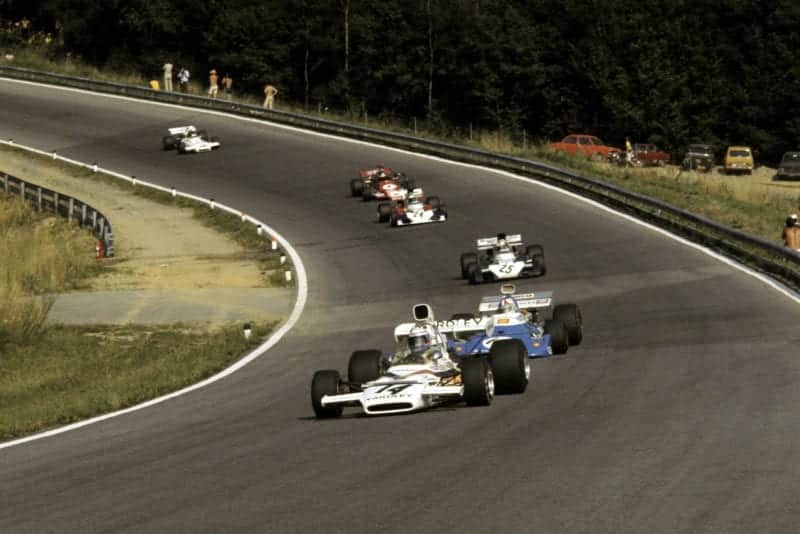
Revson leads the battle for the final podium place
Motorsport Images
Apart from the excitement among the leaders in the first ten laps all manner of happenings had been going on with the rest of the runners. Walker’s engine in his Lotus blew up in a cloud of smoke on lap seven. Stommelen stopped for repairs to the Eifelland bodywork on his March. Wilson Fittipaldi found a “foreign object” kicking about among the pedals, and stopped to throw it out. Pace had his fuel pressure gauge burst and cover him in petrol, necessitating a long stop for repairs and a change of overalls, and de Adamich was in trouble with a plug lead that did not want to stay fastened. With Regazzoni out of the way things sorted themselves out, with Stewart conscious that the chisel nose of the Lotus 72 was getting ever closer, Hulme in third place and Peterson up into fourth place from seventeenth position on the opening lap! Charging past the tail-enders seems to be the Swedish driver’s good point; passing the faster drivers is another matter altogether. Hailwood had consolidated himself in fifth place, ahead of Reutemann and Revson. the American driver’s McLaren hiccoughing at the wrong moments which was making things difficult for him. Regazzoni rejoined the race for a few laps but then gave up the unequal struggle, and at twenty laps, after he had been passed by the Tecno and then by Lauda, poor Ickx joined his team-mate in the paddock and 30,000 Italian spectators began to drift away from the circuit with a feeling of having been cheated. Reutemann had been forced to give up when the fuel injection system on his Cosworth engine went wrong, and Hill’s Cosworth engine began popping and banging. Migault was running in last place with the Connew but quietly getting on with his first Grand Prix, and was lapped by the leaders at 13 laps. By 23 laps Fittipaldi had closed right up on Stewart, but Hulme had also closed up on indicating that Stewart was somehow slowing the pace. As the Connew finished its twenty-second lap part of the left rear suspension broke away from the chassis and the car swooped across the road and this took everyone’s attention so that they hardly noticed that Fittipaldi had taken the lead from Stewart, and Hulme was challenging for second place. When Hulme got past the Tyrrell with little opposition on lap 27 it was obvious that all was not well with the blue car. It was beginning to steer at both ends. Suggesting that something was aiming adrift in the rear suspension, and from a dominant leading position Stewart had dropped to third place with not much hope of holding on to it, as Peterson was not far behind.
At 30 laps Fittipaldi’s first place looked secure enough, except that Hulme was not losing any ground, and there was an ominous “solid” look about the McLaren as it followed the Lotus round, and Revson in the second McLaren was beginning to put the pressure on Peterson’s March as they closed up on the stricken Tyrrell. Among the “non-winners” there were all manner of troubles arising. Schenken got a puncture in his left front tyre and stopped to have it changed, and then imagined he had a puncture in his left rear tyre on the next lap. Both rears were changed and he was sent on his way. GaIli stopped with the Tecno, after an excellent wheel-to-wheel race with Cevert’s Tyrrell, which amused the Italian driver immensely but depressed the Frenchman. An oilcooler on the Tecno was coming adrift from its mountings, and after it was fixed he rejoined the race, but it had not been noticed that an oil pipe had also cracked, so he was destined to visit the pits again bit later on. Wilson Fittipaldi was in trouble with a broken brake pipe and Hill retired when his injection system made the engine impossible to keep going.
During the time they were lapping a lot of the slower cars Revson found a way past Peterson, and Stewart was gamely struggling to hold fifth place, but he was fighting a losing battle as the Tyrrell just would not corner properly so he was losing speed down the straight that followed. With 40 laps gone it was painfully clear that Hulme had got the measure of Fittipaldi, the McLaren cornering much better on left hand bends than the Lotus, but the Lotus being faster on top speed. Lapping at 134 m.p.h. the two cars circulated barely one and a half seconds apart, the swarthy Hulme pushing relentlessly, but knowing there was no possibility of getting by unless the young Brazilian made a mistake. Similarly Fittipaldi knew he was safe providing his Lotus did not go wrong, but he had little in hand and the gap fell as small as half a second with ten laps still to run. Colin Chapman and his crew were looking very worried and ill at ease as the McLaren got closer and closer. but they under-estimated their protégé, driving in only his third season of Grand Prix racing as though he had been doing it for ten years. As the laps were ticked off on anxiously studied lap charts, and stop watches measured the gap that was so small that telling Fittipaldi he was 0.6 ahead seemed pointless, but Team Lotus had to tell him something each time he passed the pits, as he could not tell them anything. If he could have he would have probably said something like “I wish that New Zealand bear would go away.” The McLaren pit was all smiles, with their cars in second and third places, as well they might be, but the Tyrrell pit was a sea of gloom, for in the closing laps Stewart was being overtaken by everyone. Hailwood went by, then Amon in the Matra and then Ganley in the first of the BRMs. To add to the Tyrrell despair Cevert had been lapped, and after his battle with Galli in the Tecno he was struggling to stay ahead of Lauda, and the Frenchman hadn’t been switched on all weekend. They got some consolation when they found they were not alone in trouble, for Peterson’s Cosworth engine fuel system started playing up with the fluctuating fuel pressure, and he fell back rapidly, being passed by Hailwood, Amon, Ganley and even Stewart. The last car on the same lap as the leaders was the BRM of Beltoise, and when he went by the ailing March, Peterson gave up and stopped at the pits with only three laps to go, and then staggered off again to limp to the finish. The Tecno was also creeping round as its water temperature was sky high and Galli was keeping going with his fingers crossed.
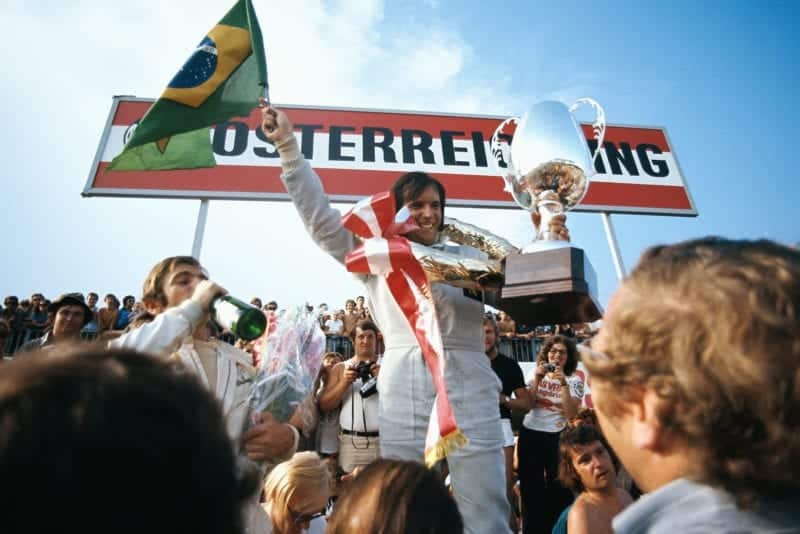
Fittipaldi is jubilant after winning
Motorsport Images
The relief in the Lotus pit could be felt as the black and gold chisel nose appeared out of the Jochen Rindt curve and Fittipaldi crossed the line, arm held-high in salute as he chalked up yet another Grand Prix victory in his outstanding 1972 season. The great crowd of Italian spectators may not have enjoyed the day, but the Austrian, German and Swiss spectators all seemed to have had a great day, as did the small, but growing band of enthusiasts who had made the long journey out from Britain to see a real Grand Prix event. Although the race was over by 4.30 p.m. there was still a lot of the glorious day left and at 10 p.m., long after dark, the beer tents were still busy, the fairground was still going strong, huge flood lights played on the paddock where the teams were finishing packing, and over the whole scene the great Steyr-Puch illuminated sign on the top of the paddock buildings, revolved slowly, silently and majestically, bidding the whole of Austria and people from far away to come back in 1973 — D. S. J.
